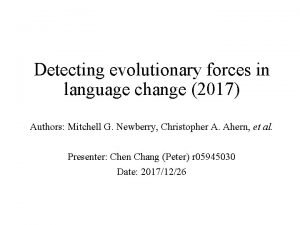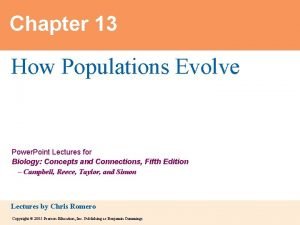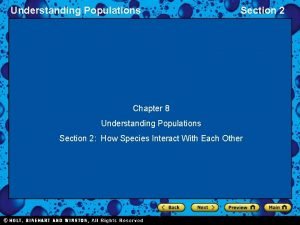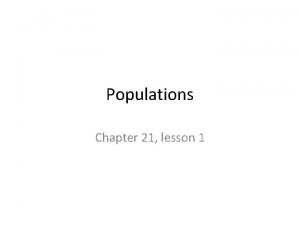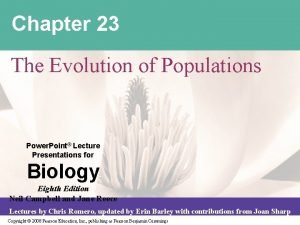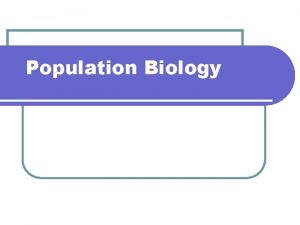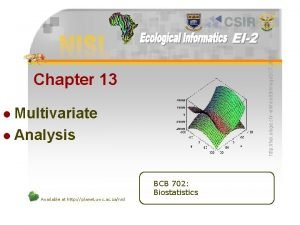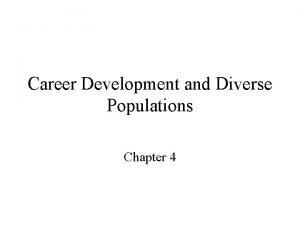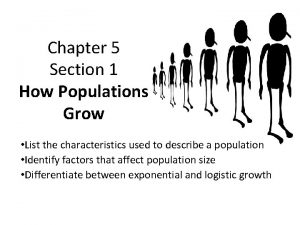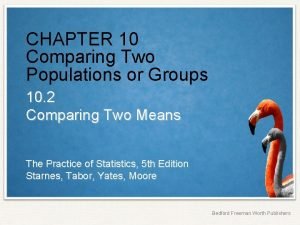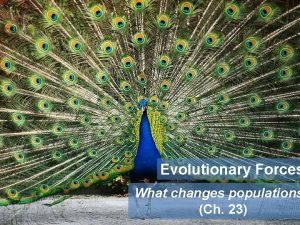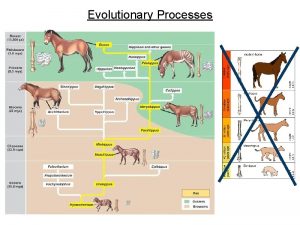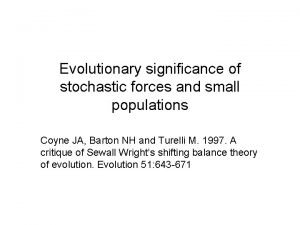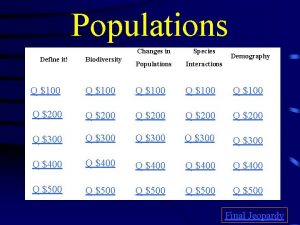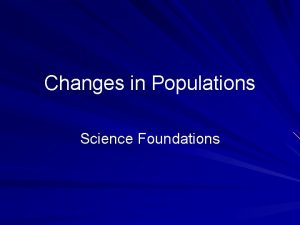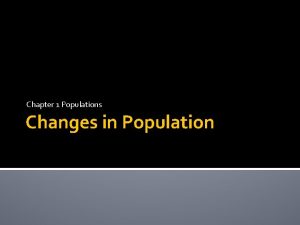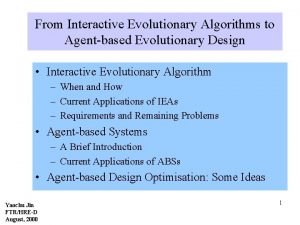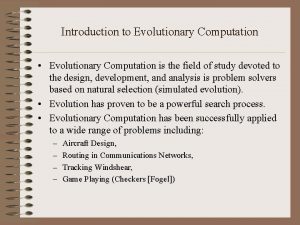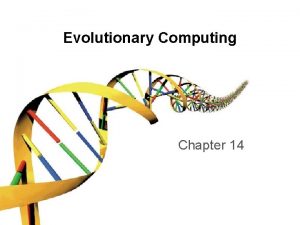Evolutionary Forces What changes populations Ch 23 Forces




















- Slides: 20

Evolutionary Forces What changes populations (Ch. 23)

Forces of evolutionary change • Natural selection – traits that improve survival or reproduction accumulate in the population • ADAPTIVE change • Genetic drift – frequency of traits changes in a population due to chance events • RANDOM change

Predation Selection • Predation selection – act on both predator & prey • • behaviors camouflage & mimicry speed defenses (physical & chemical)

Physiological Selection • Acting on body functions – – disease resistance physiology efficiency (using oxygen, food, water) biochemical versatility protection from injury HOT STUFF! Some fish had the variation of producing anti-freeze protein 5. 5 mya The Antarctic Ocean freezes over

Sexual Selection • Acting on reproductive success – attractiveness to potential mate – fertility of gametes – successful rearing of offspring Survival doesn’t matter if you don’t reproduce!

Sexual selection It’s FEMALE CHOICE, baby!

Sexual dimorphism and sexual selection

Coevolution • Two or more species reciprocally affect each other’s evolution – predator-prey – competitive species – mutualism

Effects of Selection • Changes in the average trait of a population DIRECTIONAL SELECTION STABILIZING SELECTION DISRUPTIVE SELECTION giraffe neck horse size human birth weight rock pocket mice

Genetic Drift • Chance events changing frequency of traits in a population – not adaptation to environmental conditions – founder effect – Bottleneck

Founder effect • A new population is started by a small group of individuals – just by chance some rare traitsmay be at high frequency; others may be missing – skews the gene pool of new population • example: colonization of New World • ISLANDS!!! albino deer Seneca Army Depot

Bottleneck effect • When large population is drastically reduced by a disaster – famine, natural disaster, loss of habitat… – loss of variation by chance event • narrows the gene pool

Review Questions

The following question refers to this information: In the year 2500, five male space colonists and five female space colonists from Earth settle on an uninhabited Earthlike planet in the Andromeda galaxy. The colonists and their offspring randomly mate for generations

1. After many generations, the population on this planet has an unusually high frequency for the incidence of retinitis pigmentosa, relative to Earth's population. This is most likely due to A. the founder effect. B. sexual selection. C. the inheritance of acquired characteristics. D. mutations. E. the bottleneck effect.

2. A balanced polymorphism exists through diversifying selection in seedcracker finches from Cameroon in which small- and large-billed birds specialize in cracking soft and hard seeds, respectively. If long-term climatic change resulted in all seeds becoming hard, what type of selection would then operate on the finch population? A. B. C. D. E. diversifying selection. directional selection stabilizing selection sexual selection No selection would operate because the population is in Hardy-Weinberg equilibrium.

In a very large population, a quantitative trait has the following distribution pattern:

3. What is true of the trait whose frequency distribution in a large population appears above? It is undergoing * A. directional selection. B. stabilizing selection. C. diversifying selection. D. sexual selection. E. It is not possible to say, solely from the information above.

4. The bottleneck effect A. Eliminates traits whether they are beneficial or not. B. Increases the overall variability in the population. C. Amplifies the presence of traits that will eventually lead to extinction D. Increases the adaptability of a population E. Decreases the number weak organisms in the population.

5. Which of the following statements accurately describes genetic drift? A. It occurs when individuals in a population drift out due to emmigration B. It occurs when individuals drift in to a population due to immigration C. It refers to random changes in the gene frequencies in a population due to a drop in population size D. Mutations are the cause of genetic drift E. Natural selection is the cause of genetic drift.
 Detecting evolutionary forces in language change
Detecting evolutionary forces in language change Elizabeth mulroney
Elizabeth mulroney Physical change
Physical change Chapter 23 the evolution of populations
Chapter 23 the evolution of populations 5-1 how populations grow
5-1 how populations grow Individuals don't evolve populations do
Individuals don't evolve populations do Chapter 13 how populations evolve
Chapter 13 how populations evolve Chapter 10 comparing two populations or groups crossword
Chapter 10 comparing two populations or groups crossword Territoires populations et développement quels défis
Territoires populations et développement quels défis Chapter 17 evolution of populations answer key
Chapter 17 evolution of populations answer key Founder effect
Founder effect Chapter 8 understanding populations
Chapter 8 understanding populations Lesson 1 populations answer key
Lesson 1 populations answer key Chapter 23 the evolution of populations
Chapter 23 the evolution of populations Evolution of populations section 16-1 genes and variation
Evolution of populations section 16-1 genes and variation Population definition
Population definition 99image
99image Career development of diverse populations
Career development of diverse populations Evolution of populations section 16-1 genes and variation
Evolution of populations section 16-1 genes and variation 5-1 how populations grow
5-1 how populations grow Chapter 10 comparing two populations or groups
Chapter 10 comparing two populations or groups
